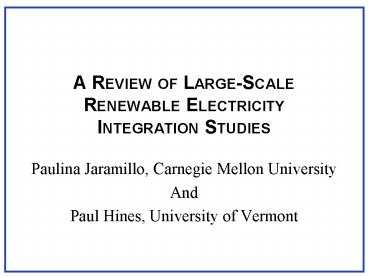A Review of Large-Scale Renewable Electricity Integration Studies - PowerPoint PPT Presentation
1 / 16
Title:
A Review of Large-Scale Renewable Electricity Integration Studies
Description:
A REVIEW OF LARGE-SCALE RENEWABLE ELECTRICITY INTEGRATION STUDIES Paulina Jaramillo, Carnegie Mellon University And Paul Hines, University of Vermont – PowerPoint PPT presentation
Number of Views:112
Avg rating:3.0/5.0
Title: A Review of Large-Scale Renewable Electricity Integration Studies
1
A Review of Large-Scale Renewable Electricity
Integration Studies
- Paulina Jaramillo, Carnegie Mellon University
- And
- Paul Hines, University of Vermont
2
Introduction
- 33 States have developed Renewable Portfolio
Standards - Many RPS call for large percentages (20) of
Renewable electricity - Wind is the fastest growing renewable source
- Wind Intermittent and Variable
www.renewelec.org
3
Integration Studies
- Several recent studies evaluate the impacts of
renewables on grid operations, and identify
strategies to mitigate these impacts. - We performed a systematic review of recent
integration studies, focusing on wind
- Goals of our review
- What grid, wind data were used?
- Evaluate methodology for estimating
- Wind power variation
- Reserves requirements
- Regulation requirements
- Identify research gaps
4
NYSERDA 2005
- 3,300 MW of Wind in New York State.
- The analysis separates among different time
scales. - Brief analysis of forecast value.
- Main recommendation Wind farms build voltage
controls and low voltage ride through capability.
- Major Concern Use of Gaussian methods for
reserve calculations - Conclusions based largely on measured standard
deviation and mean
5
Empirical comparison of real wind data and
Normal wind data
Real wind data, 31 CF, Std. Dev. ?P 21 MW
Gaussian data, 31 CF, Std. Dev. ?P 21 MW
The Gaussian assumption dramatically
underestimates the probability of multiple
sequential large changes in the same direction.
6
2006 Minnesota Wind Integration Study
- 15, 20, and 25 wind integration in MISO for
the year 2020. - Conclusion
- Penalty for variability between 2 and 4 per
MWh. - Increasing spatial diversity reduces the number
of no-wind power events, reserves requirements. - Concerns
- Gaussian methods for reserves calculations.
- Analysis gap for short term modeling.
7
2007 CAISO Wind Integration Study
- Modeled theoretical wind plants in California and
identified transmission requirements. - Conclusion
- Using Types 3 and 4 turbines will allow for
reliable wind integration. - Concern
- Use of Gaussian methods for reserve calculations.
8
2008 NRELs 20 Wind by 2020
- Not really an integration study, but a projection
of technology and economic requirements to
achieve 20 wind by 2030. - Good comparison of available wind power at
various wind speed class levels. - Recommendation Build transmission
- Concern Transmission system modeling not based
on Kirchhoffs Ohms laws
9
2008 ERCOT Wind Integration
- Analysis of impact of wind generation on net
load. - Conclusions
- Wind AND load are variable and out-of-phase.
- Seasonal variations exist.
- Reserve and regulation requirements increase with
increased wind power. - Concern
- Use of Gaussian methods for reserve calculations.
- No grid model.
10
2009 Trade Wind Integration Study - Europe
- Study focused on transmission flows to identify
transmission needs. - Assumes that regional diversity is sufficient to
deal with the variability of wind power. - No discussion about reliability and reserves.
- Potentially erroneous finding Wind and Load are
positively correlated.
11
2010 Eastern Wind Integration and Transmission
Study
- 4 different scenarios with different percentage
of wind generation and different wind production
locations. - Use of DC power flow model allows them to
identify transmission investment that will be
needed at larger wind generation percentages. - Estimated reserved requirements, forecast error,
curtailment and impacts of geographic diversity.
12
2010 SW Power Pool (CRA)
- Study 10, 20 and (limited) 40 wind
penetration. - Detailed contingency study.
- Based on hourly and limited high-resolution data.
- Conclude that no additional contingency reserves
needed.
13
2010 CEC/KEMA study of reserves and regulation
- Analyze 20 and 33 renewable scenarios.
- First large-scale study to include dynamic
generator models. - Conclude that fast-ramping storage is needed to
manage ACE and frequency deviations.
14
2010 studies by NERC, CAISO
- NERC analysis of renewables reliability
- CAISO analysis of 20 renewable in 2012 (PNNL)
- Qualitative study of reliability risks, given
renewables, DSM, storage - Emphasize the need for more load-following during
morning and evening ramps - New technology will require changes to operating
policies.
- 1-minute wind data data
- Monte-Carlo model to model forecasts
- Regulation estimates based on 1-minute data
- One of the most careful studies reviewed (but
still use standard deviations) - Emphasize need to better understand
load-following in morning/evening.
15
Research gaps
- Gaussian statistical methods Frequently
conclusions are drawn from the mean and standard
deviation of sampled wind data. - Need better models.
- Larger control areas Several studies conclude
that aggregating control areas reduces costs. - Further analysis needed.
16
Research gaps
- Meteorological vs. anemometer data
- Need empirical research to find the appropriate
role for each. - Estimation of regulation requirements
- Need new methods, for estimating regulation
needs, given accurate wind and solar data. - Morning and evening ramping
- Wind and load are generally anti-correlated
during the morning and evening. Need new
operating policies and technology































